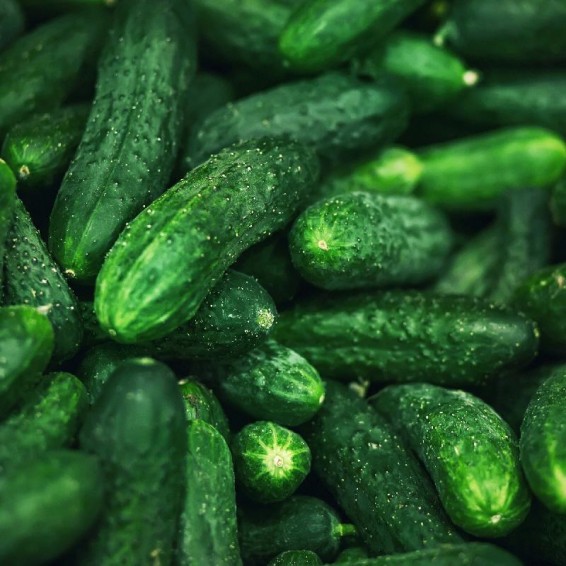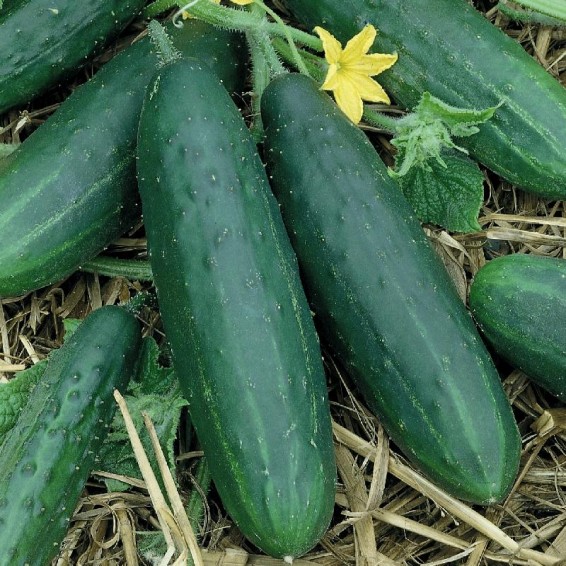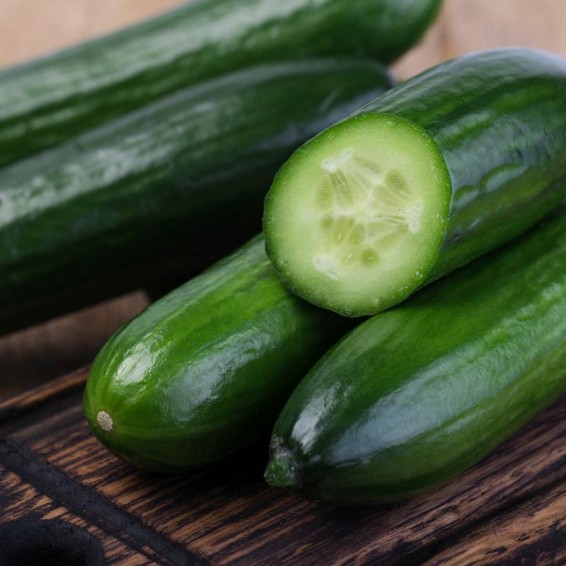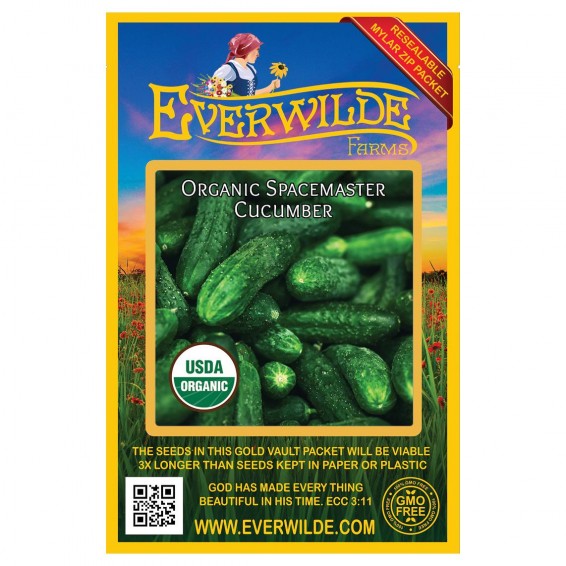Organic Spacemaster Cucumber Seeds
Cucumis sativus

- HOW TO GROW
- FAST FACTS
HOW TO GROW
Sowing: Cucumbers do not take well to transplanting, so either start them early in peat pots or plant them directly. Start them indoors about 2 weeks before frost, placing 3-4 seeds 1/2" deep in the pot. Keep the air temperature at least 80 degrees F. When two or three leaves appear on each plant, cut off all but the strongest plant with a scissors. Before planting them, "harden" the seedlings by setting them outside during the day. They should be planted no sooner than a week after the last spring frost, when the air temperatures consistently average 65-75 degrees F. For planting them in a hill, place three seedlings or 7-8 seeds in each hill; space hills 4-5' apart. If rows are preferrable, plant seedlings 1' apart or place 5 seeds within 1' and later thin them. Cucumbers love heat and cannot endure even a light frost; if cold temperatures threaten, cover the seedlings. Spacemaster cucumbers produce rather short vines, and perform well as container plants for small spaces. For companion planting benefits, consider planting several radishes with cucumbers - this seems to repel damaging cucumber beetles. However, cucumbers do not like being planted near potatoes or aromatic herbs.
Growing: Moisture is the key to growing excellent cucumbers; keep the soil consistently moist. When the vines have developed, apply mulch or straw to conserve moisture and control weeds. Watch out for cucumber beetles, and remove them immediately to prevent damage.
Harvesting: These slender, dark green cucumbers work very well for slicing. For best taste, harvest them as soon as they reach a length of 7". If picked consistently all season, the yield will be very high. When the blossom end of the cucumber begins to turn yellow, this indicates that the cucumber has passed its prime. Cucumbers store very well in the refrigerator.
Seed Saving: Cucumbers usually produce both male and female flowers in the same plant, and will cross with other varieties of cucumber; be sure to separate the varieties to prevent cross pollination. Allow the cucumbers to mature past the eating stage - the cucumber will be very soft and the skin will turn either white, brown, yellow, green, or orange, depending on the variety. This may take up to five weeks. Remove the cucumbers from the vine and allow them to cure in a dry, cool place for another two weeks. Cut open the cucumbers and scoop out the seeds into a bowl; add an equal amount of water, and keep in a 90 degree location away from sunlight for 24-36 hours. The mixture will be fermenting, and mold may form; stir it twice a day. At the end of the fermentation process, add more water while stirring - the hollow seeds and debris will float to the top, and the good seeds will sink. Remove the water and debris, and spread out the good seeds on a flat surface to dry for about two weeks. Store in a cool, dry place for up to 8 years.
FAST FACTS
Latin Name: Cucumis sativus
Type: Open Pollinated, Heirloom, Warm Season
USDA Zones: 3, 4, 5, 6, 7, 8, 9, 10, 11, 12
Seeds per Ounce: 1,000
Planting Method: Direct Sow
Sunlight: Full Sun
Height: 12 Inches
Color: Green
DESCRIPTION
HOW TO GROW
Sowing: Cucumbers do not take well to transplanting, so either start them early in peat pots or plant them directly. Start them indoors about 2 weeks before frost, placing 3-4 seeds 1/2" deep in the pot. Keep the air temperature at least 80 degrees F. When two or three leaves appear on each plant, cut off all but the strongest plant with a scissors. Before planting them, "harden" the seedlings by setting them outside during the day. They should be planted no sooner than a week after the last spring frost, when the air temperatures consistently average 65-75 degrees F. For planting them in a hill, place three seedlings or 7-8 seeds in each hill; space hills 4-5' apart. If rows are preferrable, plant seedlings 1' apart or place 5 seeds within 1' and later thin them. Cucumbers love heat and cannot endure even a light frost; if cold temperatures threaten, cover the seedlings. Spacemaster cucumbers produce rather short vines, and perform well as container plants for small spaces. For companion planting benefits, consider planting several radishes with cucumbers - this seems to repel damaging cucumber beetles. However, cucumbers do not like being planted near potatoes or aromatic herbs.
Growing: Moisture is the key to growing excellent cucumbers; keep the soil consistently moist. When the vines have developed, apply mulch or straw to conserve moisture and control weeds. Watch out for cucumber beetles, and remove them immediately to prevent damage.
Harvesting: These slender, dark green cucumbers work very well for slicing. For best taste, harvest them as soon as they reach a length of 7". If picked consistently all season, the yield will be very high. When the blossom end of the cucumber begins to turn yellow, this indicates that the cucumber has passed its prime. Cucumbers store very well in the refrigerator.
Seed Saving: Cucumbers usually produce both male and female flowers in the same plant, and will cross with other varieties of cucumber; be sure to separate the varieties to prevent cross pollination. Allow the cucumbers to mature past the eating stage - the cucumber will be very soft and the skin will turn either white, brown, yellow, green, or orange, depending on the variety. This may take up to five weeks. Remove the cucumbers from the vine and allow them to cure in a dry, cool place for another two weeks. Cut open the cucumbers and scoop out the seeds into a bowl; add an equal amount of water, and keep in a 90 degree location away from sunlight for 24-36 hours. The mixture will be fermenting, and mold may form; stir it twice a day. At the end of the fermentation process, add more water while stirring - the hollow seeds and debris will float to the top, and the good seeds will sink. Remove the water and debris, and spread out the good seeds on a flat surface to dry for about two weeks. Store in a cool, dry place for up to 8 years.
FAST FACTS
Latin Name: Cucumis sativus
Type: Open Pollinated, Heirloom, Warm Season
USDA Zones: 3, 4, 5, 6, 7, 8, 9, 10, 11, 12
Seeds per Ounce: 1,000
Planting Method: Direct Sow
Sunlight: Full Sun
Height: 12 Inches
Color: Green








